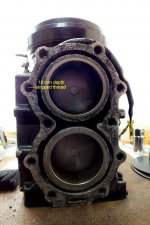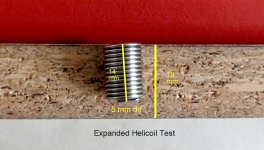Have a Blind threaded orifice as shown. It's 16 mm deep, have 15 mm length Helicoils to sort that out nicely.
View attachment 352178
when installed and tested on a hard wooden block, once the Helicoil's thread was nicely coiled into the wooden threads the Helicoil has extended 5 mm more to 19 mm and covered the total wooden width length. It's not stated if the Helicoils will lengthen farther than when compressed prior installation. Seems will go that route when installed on the stripped orifice thread which is metal.
View attachment 352172
Wanted to know if once the Helicoil is installed a new bolt will be easy to be fingered coiled ? The issue is : if expands will be easy to finger screw as the wooden test showed, if doesn't expand and once installed on a metal surface the bolt seems to go in tight will need a wrench.
Have 2 alternatives : risk installing an M8 x 1.25 x 15 mm length Helicoil and trim the excessive amount exiting the orifice with whatever is needed or install a M8 x 1.25-16 mm Time Sert with removed head to be 15 mm in length and be able to be screwed fully coiled inside the 16 mm depth thread shown in pic and avoid any further issues and time loss going for the Helicoil. Don't have the special tool to drill and expand the beginning of the orifice for the protruding round head to sit flat on the metal wall once fully screwed in that's why a small length resize without the head is needed.
Happy Boating
You lost me with all this talk of wooden dowels, finger tight, etc….
You can’t half butt the install of a helicoil in a high torque applications. I would highly recommend having the insert installed professionally using the appropriate, drill size, tap and insert
To answer your question….helicoils are stronger than the base metal.
The length of the heli-coil is determined by the type of material your installing the insert in and torque the insert is required to hold. It is rare, if ever, that you need to match thread counts 1:1….
Here is a insert length calculator. Can’t tell from the picture of the block is cast steel or cast aluminum. You will need to determine the material of the casting and its shear strength to calculate the appropriate insert length and drill size.
Here is the data sheet of the lengths and options once you determine the insert requirements
























